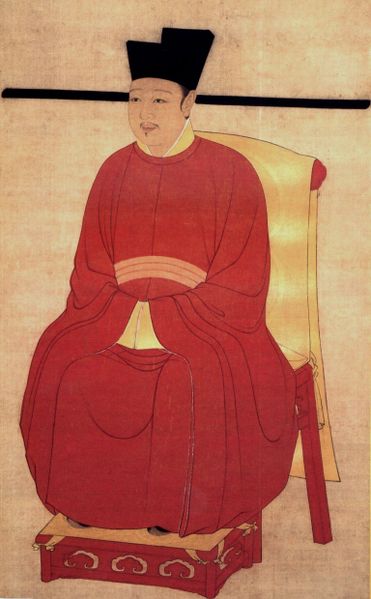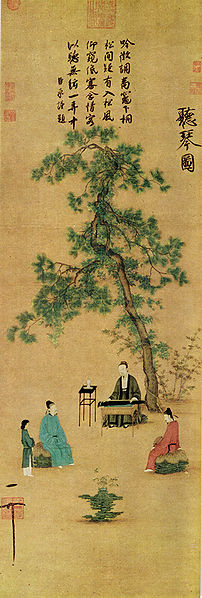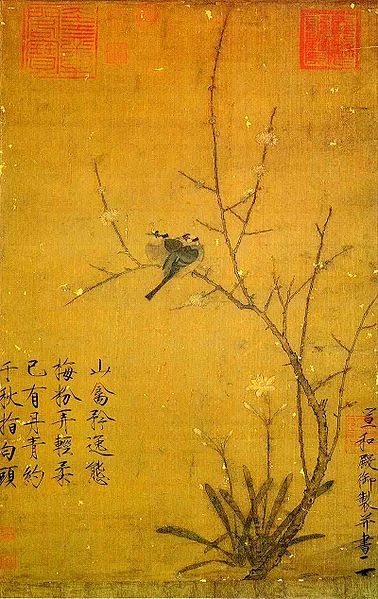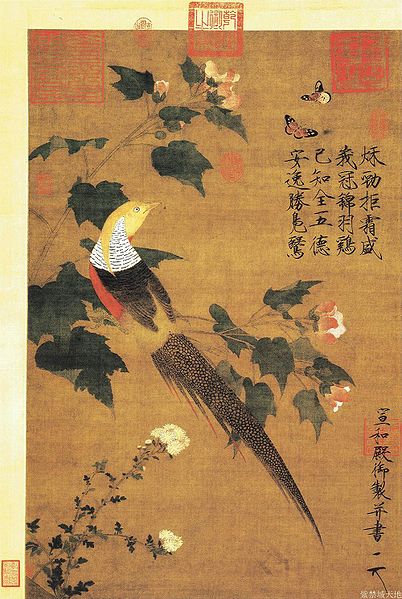<Back to Index>
- Philosopher Georges Eugène Sorel, 1847
- Sculptor Mark Matveyevich Antokolski, 1843
- Song Emperor of China Huizong, 1082
PAGE SPONSOR

Emperor Huizong (November 2, 1082 – June 4, 1135) was the eighth and one of the most famous emperors of the Song Dynasty of China, with a personal life spent amidst luxury, sophistication and art but ending in tragedy.
Born Zhao Ji, he was the 11th son of Emperor Shenzong. In February 1100 his older half - brother Emperor Zhezong (哲宗) died without a surviving son, and Huizong succeeded him the next day as emperor. He reigned from 1100 to 1126.
Huizong was famed for his promotion of Taoism. He was also a skilled poet, painter, calligrapher, and musician. He sponsored numerous artists at his court, and the catalogue of his imperial painting collection lists over 6,000 known paintings.
His temple name means "Honorary Ancestor." Emperor
Huizong of Song, besides his partaking in state affairs that favored
the Reformist party (reformers and conservatives in Song Dynasty), was a cultured leader who spent much of his time admiring the arts. He was a collector of paintings, calligraphies, and antiques of
previous Chinese eras, building huge collections of each for his
amusement. He wrote poems of his own, was known as an avid painter,
created his own calligraphy style, had interests in architecture and
garden design, and even wrote treatises on medicine and Daoism. He
assembled an entourage of court painters that were first pre-screened
in an examination to enter as official artists of the court, and made
reforms to court music. Like
many learned men of his age, he was quite a polymath personality.
However, his reign would be forever scarred by the decisions made (by
counsel he received) on handling foreign policy, as the end of his reign marked a period of disaster for Song China. A
true artist, Huizong neglected the army, and Song China became
increasingly weak and at the mercy of foreign enemies, despite his recasting of the symbolic Nine Tripod Cauldrons in 1106 in an attempt to assert his authority. When the Jurchen of Manchuria founded the Jin Dynasty and attacked the Liao kingdom
to the north of the Song empire, the Song court allied with the Jin and
attacked the Liao from the south. This succeeded in destroying the Liao
kingdom, a long time enemy of the Song. However, an enemy even more
formidable, the Jin, was now on the northern border. Not content with
the annexation of the Liao kingdom, and perceiving the weakness of the
Song empire, the Jin soon declared war on their former ally, and by the
beginning of 1126 the troops of the Jin "Western Vice-marshal" Wanyan Wolibu crossed the Yellow River and came in sight of Kaifeng, the capital of the Song empire. Stricken with panic, Huizong abdicated on January 18, 1126 in favor of his son who became Emperor Qinzong (欽宗). Overcoming
the walls of Kaifeng was a difficult undertaking for the Jin cavalry,
and this, together with fierce resistance from some Chinese officials
who had not totally lost their nerve, as Huizong had, resulted in the
Jin lifting the siege of Kaifeng and returning north. The Song empire,
however, had to sign a humiliating treaty with the Jin, agreeing to pay
a colossal war indemnity and to give atribute to Jin every year. But
even such humiliating terms could not save the Song empire. Within a
matter of months, the troops of both Jurchen vice - marshals, Wolibu and Nianhan, were
back south again, and this time they were determined to overcome the
walls of Kaifeng. After a bitter siege, the Jin eventually entered
Kaifeng on January 9, 1127, and many days of looting, rapes, and
massacre followed. Huizong, his son Emperor Qinzong, as well as the
entire imperial court and harem were captured by the Jin in the Jingkang Incident, and shipped north, mostly to the Jin capital of Shangjing (near today's Harbin). One of the sons of Huizong managed to escape to Southern China where, after many years of struggle, he would establish the Southern Song Dynasty, of which he was the first emperor, Emperor Gaozong (高宗). Huizong
and Qinzong were demoted to the rank of commoners by the Jin on March
20, 1127. Then on May 10, 1127, Huizong was deported to northern
Manchuria, where he spent the last eight years of his life as a
captive. In a humiliating episode, in 1128 the two former Song emperors
had to venerate the Jin ancestors at their shrine in Shangjing, wearing mourning dress. The Jurchen rulers granted the two former emperors offensively named ranks of the Marquess (侯, hou) of Hunde (昏德, "Muddled Virtue") and marquess of Zhonghun (重昏, "Doubly muddled"). In 1137, the Jin formally notified the Southern Song court about the death of their captive. The
man who once had been the most powerful ruler on earth and had lived in
opulence and art died a broken man in faraway northern Manchuria in
June 1135, at the age of 52. A
few years later (1141), as the peace negotiations between the Jin and
the Song were proceeding, the Jin posthumously honored Huizong with the
neutral sounding title of Prince of Tianshun qun, after a commandery in the upper reaches of the Wei River (now in Gansu). His son, still alive, became styled the Duke (公, gong) of Tianshun qun. His
third brother, Zhao Si King Yue (越王赵偲), lived in Gioro, was the founder
of the clan Gioro in which the Qing Imperial Family Aisin Gioro is a
cadet branch. Gioro clan was split into Gioro and Donge (董鄂). Huizong was a great painter, poet, and calligrapher. He was also a player of the guqin (as exemplified by his famous painting 聽琴圖Listening to the Qin); he also had a Wanqin Tang 『萬琴堂』 ("10,000 Qin Hall") in his palace. Huizong
took huge efforts to search for art masters. He established the "Han
Lin Hua Yuan"[翰林画院] ("Han Lin imperial painting house") where top
painters around China share their best works. The primary subjects of his paintings are birds and flowers. Among is works is Five-Colored Parakeet on Blossoming Apricot Tree. He also recopied Zhang Xuan's painting Court Ladies Preparing Newly Woven Silk, and Emperor Huizong's reproduction is the only copy of that painting that survives today. He invented the "Slender Gold" (瘦金體)
style of calligraphy. The name "Slender Gold" came from the fact that
Huizong's writing resembled gold filament, twisted and turned. His
era name of Xuanhe is also used to describe a style of mounting
paintings in scroll format. In this style, black borders are added
between some of the silk planes. In 1114, following a request from Emperor Yejong of the Korean court of Goryeo, Huizong sent to the palace in the Goryeo capital at Gaeseong a
set of musical instruments to be used for royal banquet music. Two
years later, in 1116, he sent another, even larger gift of musical
instruments (numbering 428 in total) to the Korean court, this time yayue instruments, beginning that nation's tradition of aak. Huizong was also a great tea enthusiast. He himself wrote the famous Treatise on Tea, the most detailed and masterful description of the Song dynasty sophisticated style of tea ceremony.



